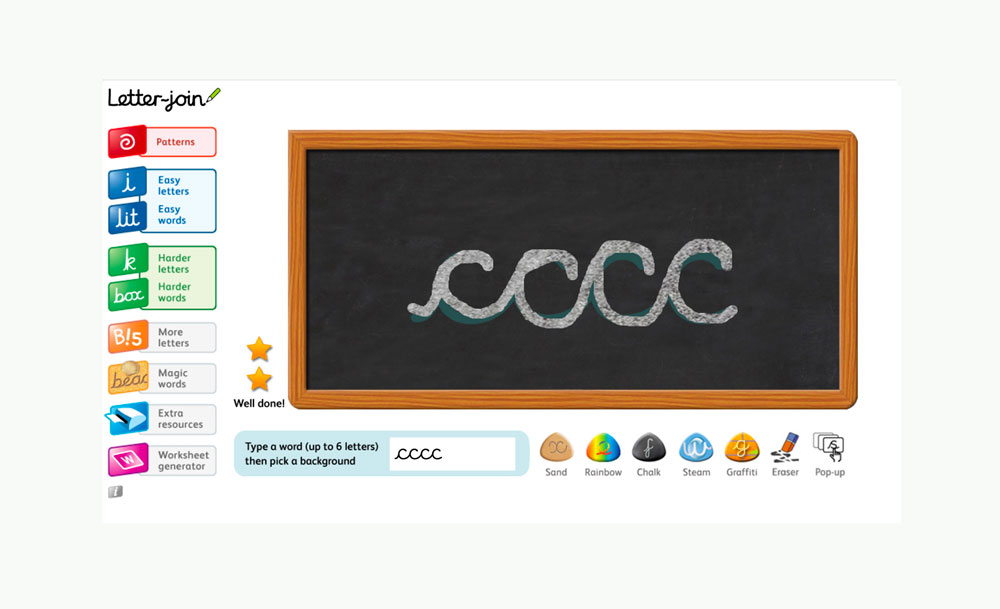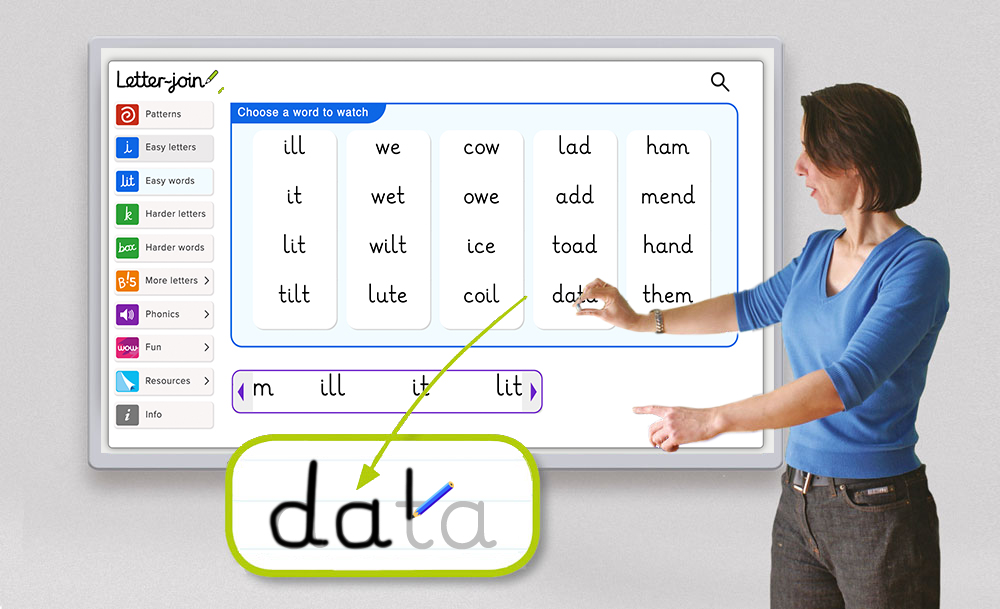Follow Letter-join’s Lesson Planners for a whole school approach to handwriting

Each of the key stage requirements are met through Letter-join’s handwriting Lesson Planners, written by teachers and editors experienced in primary education. Our aim is for children to develop a fluent and legible, handwriting style to ensure they reach the standard expected at the end of each key stage. Many suggestions for differentiation are included in each section in order that every child has the opportunity to master the relevant skills.
Early Years

Letter-join offers the option to start teaching handwriting using printed letters, for all resources and worksheets, before moving on to cursive handwriting.
Pre-cursive patterns and shapes can be challenging for young pupils, but Letter-join has all the resources needed to introduce joined-up handwriting to younger children.
Letter-join’s animations model pre-cursive patterns with fun sounds that can be copied by air-writing or by tracing on IWBs, tablets and, most importantly, by practising with a pencil on printed worksheets.
This naturally leads on to the introduction of real letters. Watching and copying the shapes of letters and the various joining techniques will enable pupils to learn to write simple words in a cursive style at this early stage.
Module 1 Print
For teaching handwriting using the printed method. Resources supporting the printed font include all animations, lowercase letters and words, phonics, games and activities and KS1 worksheets.

Handwriting can be fun and using Letter-join can help reinforce handwriting with a variety of fresh activities. To support handwriting at school, pupils can also log into Letter-join at home, accessing all the resources including the touch-screen activities on iPads and tablets.

Ready for the final round of handwriting challenges? When pupils master these they’ll be true handwriting champions!
Module 1 Cursive
Covers pre-cursive patterns and continuous cursive, lower case letters with or without lead-in lines. It starts with Getting Ready for Handwriting: warm-up exercises, sitting position and tripod pencil grip. At the end of this module children should be able to form and join all lowercase letters.
Ks1

Handwriting can be fun and using Letter-join can help reinforce handwriting with a variety of fresh activities. To support handwriting at school, pupils can also log into Letter-join at home, accessing all the resources including the touch-screen activities on iPads and tablets.
KS1 is the time to introduce new letterforms (capital letters, numbers, the uses of printed letters and punctuation). Letter-join animates all of these to show the correct formation providing ready-made worksheets for labelling and form-filling using capital and printed letters.
Pupils should also be looking to produce neater handwriting with consistent spacing and letter sizes as well as developing ‘speedy handwriting’ which can be practised using Letter-join’s dictation exercises.
Module 2 Print to Cursive
Module 2 is for teaching how to write capital letters, printed letters, numbers and symbols alongside cursive handwriting using Letter-join’s on-line and printed resources. Children will practise their fine and gross motor skills with Letter-join’s warm up activities, learn how to sit correctly for handwriting using the tripod grip and will be introduced to the different letter families.
Module 2 Cursive
Children will increase the fluency and speed of their handwriting through regular practice, improving letter formation and orientation of letters. Worksheets include high frequency words, joining practice, dictation exercises and SPaG practice in readiness for KS1 SATs.
Module 3 Starting Cursive
Children are introduced to writing cursive letters and how to join them. They will have regular practice in letter formation and joining their handwriting.
Module 3 Cursive
Children increase the fluency and speed of their handwriting through regular practice, improving letter formation and orientation of letters. Worksheets include high frequency words, joining practice, dictation exercises and SPaG practice in readiness for KS1 SATs.
Ks2

Ready for the final round of handwriting challenges? When pupils master these they’ll be true handwriting champions!
Building on KS1 skills, pupils will be writing passages of text neatly and speedily, labelling diagrams using printed letters appropriately and filling in forms using legible writing.
Letter-join’s resources will help pupils acquire a feel for neatness and quality in their final handwritten work. The dictation resources will help to develop handwriting stamina when writing.
With the support of Letter-join, pupils will have covered all the criteria necessary by the end of Year 6 to reach the standards set out in the 2014 National Curriculum for handwriting.
Module 4: Year 3
The handwriting lessons in Module 4 are presented in sets of two lessons per week and are designed to improve legibility, consistency and quality of handwriting. It is targeted at Year 3 children in lower KS2 where pupils should be using joined handwriting throughout their independent writing.
The worksheets for this module cover a variety of curriculum topics: Dictation, double letters, number vocabulary, palindromes, tongue twisters, MFL (French and Spanish), onomatopoeia, simile, WOW words and spellings.
Module 5: Year 4
Module 5 focuses on using handwriting practice to support other subjects in the curriculum and, at the same time, builds on fluency and consistency. This module aims to promote meaningful links with other subjects such as English, maths, science, geography, French and Spanish. Making such links enables children to apply the skills they are learning in context and also provides depth to the curriculum. Learners will continue to develop legible handwriting through the regular practice offered in this module’s lessons.
Module 6: Year 5
Module 6 continues to build on combining fluent handwriting with other subjects across the curriculum. In this module, learners will have plenty of opportunity to develop the stamina and skills to write at length, with accurate spelling and punctuation. With Letter-join’s wide range of resources, they will be able to work towards producing consistently neat and well-presented handwriting in all curriculum subjects. By the end of this module, children should be producing cursive writing automatically, enabling them to focus on the content of their work rather than the process of writing.
Module 7: Year 6
The aim of Module 7 is to ensure that handwriting is neatly presented and clear in readiness for KS2 SATs and is the expected standard of handwriting for Year 6. Learners will consolidate the stamina and skills required to write at length, with accurate spelling and punctuation. They will develop more of a personal handwriting style as they write with automaticity and will learn to write at different speeds with different attention to neatness, depending on the task.
Promoting speedy, fluent writing continues to be a strong feature in Module 7. Challenging dictation exercises will refine pupils’ revising and checking skills as well as boosting their handwriting speed, stamina and fluency. A range of curriculum-based worksheets will give pupils the opportunity to practise writing at length.
By the end of this module, children should be able to adapt their handwriting for a range of tasks and purposes and to create different effects. They should be clear about what standard of handwriting is appropriate for a particular task, for example, quick notes, a final handwritten version, an un-joined style or capital letters. All of these writing styles are covered in this module.
KS2 Handwriting Recovery Programme
Letter-join’s Handwriting Recovery Programme is aimed at pupils in upper Key Stage 2 and above who require extra handwriting support. It includes teacher assessments, lesson plans, links to worksheets and online activities and suggestions for further practice.
Handwriting Assessment Tracker
Letter-join’s Handwriting Assessment Tracker Pack has been designed in line with National Curriculum targets for handwriting. It provides a complete scheme for assessing pupils’ progression in handwriting skills from Early Years to Year 6.
Inclusion
Letter-join is an excellent resource for teaching children with special educational needs, particularly dyslexia.
It delivers a multi-sensory approach to learning handwriting, which is fundamental when teaching dyslexic pupils. Letter-join's combination of interactive animations, games, activities and worksheets enables children to experience a range of visual, auditory, kinaesthetic and tactile factors of teaching and learning.
See our Dyslexia document >
See our Dyslexia document >
Letter-join’s Handwriting Recovery Programme offers a concise step-by-step intervention tailored to improve a specific skill in children whose handwriting is limited by difficulties with fine motor development, including left-handed children.
Adult learnersFurthermore, Letter-join provides a useful tool-kit for adult learners and students learning English as a foreign language.















